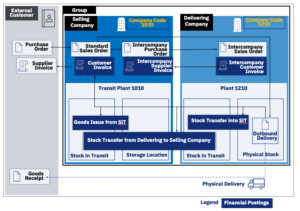Trade Intercompany, Realtime Profit in Inventory Eliminations, and Value Chain Analysis in S/4HANA
Authored by Vanda Reis, Associate Partner, TruQua, an IBM Company
Advanced Intercompany Sales using the Universal Parallel Accounting Consolidated View
When facing the speed and complexity of current business scenarios it’s easy to see how organizations find it challenging to execute a complete and systematic value chain analysis. Consider your SAP system and how it was designed; Which activities were in place at the “conceptual” design, and how has your organization outgrown those activities? Can your SAP applications provide the necessary information to support your organization’s end-to-end value chain analysis, competitive advantage, and strategy?
For long-term SAP ERP customers, successfully managing intercompany processes and value chains typically requires significant effort to reduce inconsistencies and inaccurate information. The good news is that innovative technologies in S/4HANA are going in the right direction to support integrated end-to-end business processes and visibility to activities within the value chain. Many functionalities are already available within SAP S/4HANA to improve the view of the value chain in real-time and consistently across all levels of an organization.
One example is SAP Advanced Intercompany Sales (AIS). AIS addresses several gaps in the classic intercompany processes within SAP-ECC. It enables organizations to streamline and automate their intercompany sales processes and create a true value chain of all the material movements. AIS also provides a centralized platform for managing the entire intercompany sales lifecycle, starting from order creation to billing and financial settlement. Finally, AIS helps organizations overcome the challenges associated with intercompany transactions, such as ensuring accurate pricing, maintaining proper documentation, and complying with tax regulations.
Another example is the business function called FINS_PARALLEL_ACCOUNTING_BF which activates the Universal Parallel Accounting (UPA). Released in S/4HANA Cloud public edition 2015, this function became available at the end of 2022 to S/4HANA private cloud and on-premise customers. With UPA, organizations can maintain separate accounting ledgers and financial statements based on different accounting principles and valuation views.
One of UPA’s most expected and impactful innovations is the consolidated group view for intercompany transactions. This feature allows organizations to distinguish between the transfer prices used by the legal view and the inventory value used by the group view valuation, resulting in a true group margin and group level Cost of Goods Sold (COGS) at each step of the material value chain.
You may already be familiar with the group valuation approach with SAP ECC. In ECC EhP5, SAP released the business function “Stock in Transit and Actual Costing” (LOG_MM_SIT), which supports an organization’s cross-company code stock transfer with valuated stocks in transit and actual costing cross-company codes. The material ledger/actual costing then includes stock in transit in the actual costing multilevel price calculation.
UPA takes the group valuation to another level by introducing a consolidation-like approach that uses a separate single-valuation ledger specific for group valuation to eliminate intercompany revenues and COGS. With UPA, the intercompany goods movements are recorded “at cost” across the value chain, ensuring that profit in inventory is excluded in the group view.
Together UPA and AIS provide a centralized platform for managing the entire intercompany sales lifecycle, starting from order creation to billing and all finance posting for legal and group valuations.
Consider the following scenario: A customer orders a product from a sales organization under company code 1010 in Germany. Due to inventory constraints, that order is seamlessly delivered from another company within the same group (company code 1210) in France. The physical delivery happens from company code 1210 in France directly to the customer. Still, financially, inventory value is transferred between the two companies before the product ownership moves to the customer.

Figure 1: Customer scenario with the AIS processes, the value chain monitor, and UPA financial postings
This video demo illustrates this scenario with the AIS processes, the value chain monitor, and UPA financial postings (legal and group views).
FINS_PARALLEL_ACCOUNTING_BF is automatically activated in S/4HANA cloud deployment. For private cloud and on-premise deployments, this function has been optional since the end of 2022. Important to note that activating this business function needs to be carefully studied. There is a series of prerequisites, current limitations, and profound implications in multiple business processes of S/4 HANA. In addition, once this business function has been activated, it cannot be deactivated.
In summary, SAP S/4HANA UPA and AIS bring transparency and harmonization that helps organizations to streamline and automate their intercompany sales processes and global financial operations, improve compliance with diverse accounting standards, and gain greater transparency into their financial performance across different entities.
For more information on Advanced Intercompany Sales using the Universal Parallel Accounting Consolidated View in SAP S/4HANA, please contact us.
About the Author

Vanda Reis has extensive experience in technology strategy and delivering business transformation. She has broad experience planning and executing strategic & tactical IT roadmaps driven to business excellence. Throughout her career, Vanda had the opportunity to apply her knowledge and leadership in technology, whether building technical solutions at Fortune 500 companies, leading successful IT teams, coaching, or leading diverse and virtual teams. Vanda has a degree in Computer Sciences and a master’s in Managing Information Technology. Recently she completed a Chief Digital Officer certification at Carnegie Melon University. She has published several technical articles and two books at SAPpress.com and Amazon.com.
Sources
SAP TechEd: https://www.youtube.com/watch?v=FhkXmycLliw
SAP Note https://me.sap.com/notes/3191636
SAP Community: https://blogs.sap.com/2022/10/21/universal-parallel-accounting-in-sap-s-4hana/
SAP Community: https://blogs.sap.com/2022/10/24/inventory-accounting-and-universal-parallel-accounting-in-sap-s-4hana-2022/
SAP Community: https://blogs.sap.com/2022/10/10/insights-into-value-chain/

